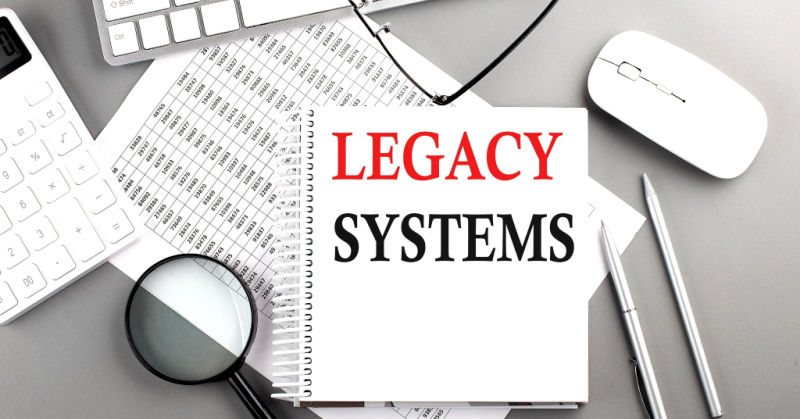In business (and sometimes in our personal lives), technology is changing at such a rapid pace, that it can feel overwhelming.
And yet, as technology becomes more and more central to business operations, staying competitive requires a close look at your software.
There isn’t a magic formula for deciding which “tech stack” or suite of software tools is best for your business. However, as a business leader, you should be aware of the possibilities in the market — and when you may want to consider a change.
Particularly for business-critical software, like your Enterprise Resource Planning (ERP) software or platforms for processing inventory, invoices, and payments, staying up-to-date with tech tools can have a far-reaching impact on all of your business activities.
Here, we’ll cover a few concepts that are good to keep in mind as you consider updates to your tech stack. Particularly if your business uses technology that has been around for a long time— frequently referred to as “legacy software”—these resources can help you prepare to explore the next generation of software.
When Do You Need to Make a Software Change?
Before diving in, it’s worth noting that for most software decisions, you don’t need to make an immediate change. Rarely is a software transition an absolutely urgent request.
However, reviewing the performance of your software is a key piece of your long-term strategy. Changes in software may be debated over months, quarters, or even years. Any change is likely to require resource planning for both staff time and the company budget.
Depending on the details, implementing new software across your organization can be a big lift for your team, and the change should not be taken lightly.
If you picked your software 2, 5, or even 10+ years ago, your business has likely changed a lot throughout that time. Your business is constantly changing; being adaptable can help you keep a competitive edge. Whether you’ve outgrown the software that was originally chosen, or there are new tools on the market, considering new technology can ultimately provide an opportunity to transform company processes.
Navigating Legacy, Maintenance-Only, the Cloud, and More
The world of software can appear a bit cloudy from the outside. Terms aren’t always standardized, the reasoning behind software development decisions is opaque, and there are more choices than you’ll know what to do with.
Particularly if you use legacy or relatively mature software, there are a few concepts to keep in mind while navigating new waters.
Locally Managed Servers vs Cloud-Based Systems
Locally managed servers, also known as on-premises systems, require software to be installed and managed at your business location, on the company’s own servers. Your business purchases the software upfront, and you are required to manage it, with varying levels of support from the software provider.
Because these solutions are on-premises systems, your business usually needs to retain internal or outsourced IT to help to manage maintenance, software upgrades, data configuration, and back-ups. Locally managed servers also require physical space in your business for IT infrastructure.
Cloud-based systems involve implementing software with the services delivered over the internet. The system’s servers, databases, networking, and storage is managed by your software vendor, and your business accesses and manages data using the internet to access what is stored in the cloud. This usually relies on a browser-based setup, and some businesses also take advantage of VPN access or a remote desktop protocol.
Because this software is managed on the vendors’ servers, your vendor takes responsibility for much of the IT maintenance. The software should have built-in regular updates that review functionality, security, and efficiencies.
Without the need to keep all of these software resources in-house, your business isn’t required to manage the IT and maintenance, and you also don’t need to physically store servers and as much IT infrastructure in your business.
Cloud-based systems do usually require monthly or annual fees, which fund regular upgrades and maintenance that keep you always up-to-date. In addition, with more interactions with your vendor, there are more opportunities to provide input on the functionality and features your business would like to see developed.
Pivoting to Cloud Software
If you’re tired of being stuck with a locally-managed software, particularly for business-critical components like your ERP, there may be an inflection point where your business considers a move to cloud-based servers. That may mean changing from legacy systems (for instance, QuickBooks Desktop, Dynamics GP, Dynamics SL, Sage 200) to instead trying cloud-based options like Netsuite and QuickBooks Online.
Once your business is using a cloud-based solution for something like your ERP, you can also take advantage of specialized tech tools like Plate IQ for AP automation in the cloud (because your business’ technology shouldn’t be a Swiss Army knife).
“Maintenance-Only Mode” vs. Sunsetting Software
Maintenance is a requirement for software companies because it is paid for and expected by customers. Companies need to devote resources to fix any bugs, errors, and requirements from integrations.
While the exact boundaries aren’t defined, a “maintenance-only mode” software is usually when a product is just being maintained, and new features are being developed less often.
How can you spot signs of maintenance only? It may just be that there isn’t much of a strategy with the future road map, and the only focuses are maintenance and fixing any bugs, rather than offering new functionality.
Start by asking yourself: How many new features have been delivered in the past 12 months? When you look at some of the tools you use, do you notice missing features that you see marketed elsewhere? Slow speeds or increasing errors? No road map offered by the developers for additional functionality in the software?
The answers to those questions may indicate it’s time to start exploring a different version of the software or a new platform entirely.
Of course, as mentioned, you may not need to switch software immediately. The functionality of your legacy software might fit what your business needs at the moment. In fact, many software solutions may stay active and relevant for a long period of time, even years, in maintenance-only mode.
However, at a certain point, maintenance-only can slide into under-maintenance that no longer meets your needs and can’t keep up with the changing tech landscape. Or, if a software solution is on the market without adequate support from the developer, the maintenance may become no longer viable and the system moves into a different category: sunsetting.
While a software developer may not usually use the exact term “sunsetting software” in their marketing materials, the concept refers to when a software solution enters a “no-maintenance” mode. Essentially, the software is retiring and being phased out on a particular timeline by the vendor.
There are many reasons software might be “sunset.” Usually, it comes down to resource allocation for the software company. Based on sales and expenses, there is a limited amount of resources the company can devote to software development across all their products.
Over time, fewer resources may be devoted to maintenance. Customers might have left the platform, or the core technology has completely changed since the original product was created. The company might undergo a major change, going out of business or switching the focus of its offerings. Or, simply, the company needs to balance creating new products and supporting older versions, and at some point the scale tips toward new products.
If the company has stopped support and development on the product (like QuickBooks Desktop announced with discontinuation of certain services on older versions), the software is no longer being updated. At this point, the software company will likely sunset the product, rather than risk expensive security breaches, and other inconveniences.
Proactive Changes in Software
Ideally, your company will avoid sunsetting software, in the hope of steering clear of unwelcome surprises. If you are familiar with the needs of your business and regularly review your tech tools to ensure they meet your needs, you can proactively make changes in your tech stack to adapt before there are any major software disruptions.
Why Consider Making the Switch in Your Software?
There are many reasons to stay ahead of the curve with your tech stack.
Optimizing Employee Resources
The systems that your employees use every day have an enormous impact on overall company efficiency and processes. Does the software you use allow employees to work effectively? Is there room for time savings or new productivity? Or the opportunity for more accuracy? Software can help your business in more ways than one, adding efficiencies that can help add to your bottom line while also helping you address changes in the labor market.
Taking Advantage of Missed Opportunities
Your current system may work adequately for many areas of your business, but your business stays competitive by changing with new developments in the market. New tools in software systems can help streamline complex processes or automate tasks that are repetitive (such as automatically indexing invoice information).
Mitigating Risk
Using an older technology that may not have robust support can not only create inefficiencies for your company but can also present a security risk. If your software vendor is scaling back development resources for your software, you may be at risk for more IT issues like unreliable data access and storage.
Reimagining Business Operations
Updating your tech stack can also provide the opportunity to rethink some of your processes and how you use the data generated by your business. A new, specialized system can help centralize your data, standardize formatting, remove duplicate or irregular information, find new insights, and enable a user-friendly, accessible experience.
Making the Switch Happen (With Minimal Headache)
Cloud-based, modern solutions for your business operations can help your company grow at the same speed as technology in the industry.
If your company is looking to move to a savvy solution for automating invoice processing, accounts payable, and vendor payments, consider scheduling a demo of Plate IQ’s AP automation software. Sign up for a personalized demo for your organization below.
.png?width=150&height=63&name=TWRlogo-regmark_blueblack%20(1).png)
.png)










Do you have questions about this article? Email us and let us know > info@woodard.com
Comments: